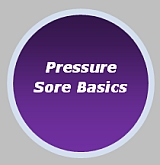Pressure Sores Basics, What are pressure ulcers?
PRESSURE SORE BASICS
What are pressure ulcers? Pressure ulcers, are otherwise known as bed sores or pressure sores, these are hurtful skin ulcers which develop once continuous force is applied on certain parts of an individual’s body. This occurs when there is a limited amount of blood flow to that particular area on the body that is surrounding the skin, especially over bony locations. Initially, if there is skin damage that may surfaces to the skin in the form of redness (harder to detect in darker skinned individuals). As the pressure ulcer advances, skin will begin to deteriorate. Not to scare anyone, but it takes as little as two hours of continuous pressure on a centralized area which can result in a ripple effect. It can lead to not only skin damage, but also tissue, ligament and bone damage. Repositioning often is essential.
During the beginning stages, bed sores can be cared for in your own home by simply reducing the pressure off the sore. Cleansing the sores and using the proper dressing. At subsequent stages, serious specialized medical treatment will be required. Regardless seeing your physician is essential even at the earliest stages of pressure sores.
More often pressure sores are particularly common around the tail bone, bum, elbows, not to mention on bony bulging regions, for instance around the ears, shoulder, hip area, knees, ankles and heels. Individuals who are in wheel chairs or bed bound are especially at risk.
AT A GLANCE…
Points to consider: Pressure sores are primarily caused by constant pressure, chaffing, and moisture (from not moving around to air out the area under pressure). Pressure sores increases the risk of catching an infection.
Associated risk for pressures ulcers/sores: The age of the person, lack of mobility, Urinary & Bowel Incontinence, poor diet, lack of hydration can lead to pressure sores that really hurt. Health conditions and ailments which will decrease recovery and / or reduce psychological consciousness (like sedatives and or mental illnesses)
LOOK FOR THE FOLLOWING SIGNS…
Warning signs of pressure sores: Discoloration, chaffed of puffy skin, particularly over bony areas. Look for bruised (maroon or purple) local region of discolored intact skin or blistering, shearing of skin. The region could be preceded by tissue that is painful, a bit more solid, soft, squashy, not the same temperature (feel wise) as the surrounding area, or any signs of infection.
-Seek specialized treatment without delay, and have them treat existing sores. Additionally insist that health care professional checks other potential pressure sore candidate areas.
For additional details, please visit the following source. And remember, this article is for informational purposes only. Read our disclaimer, click this link.

